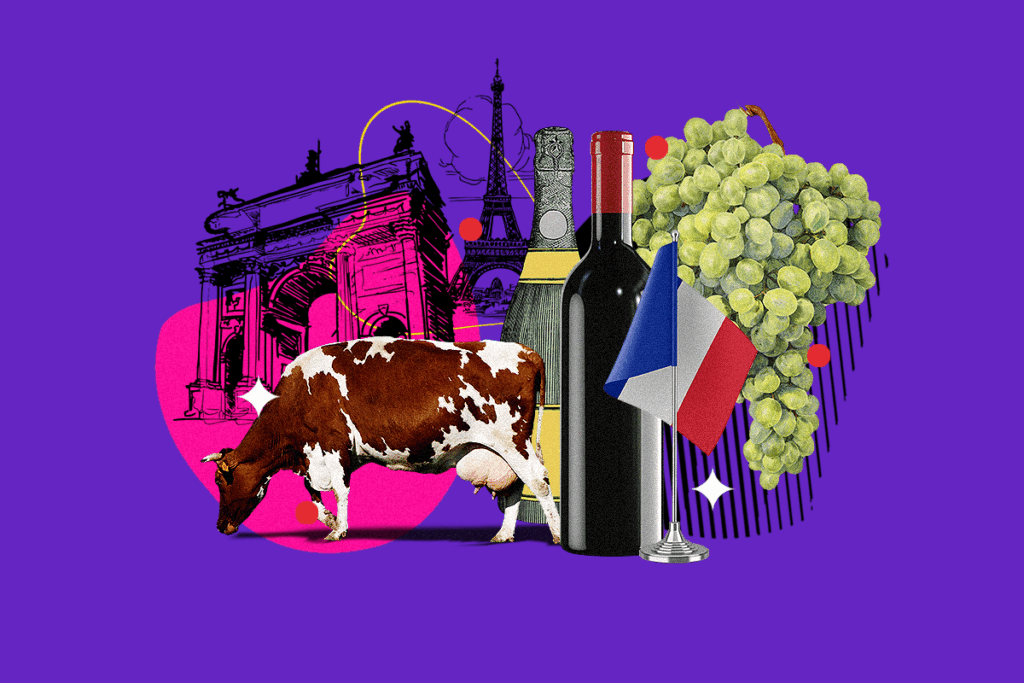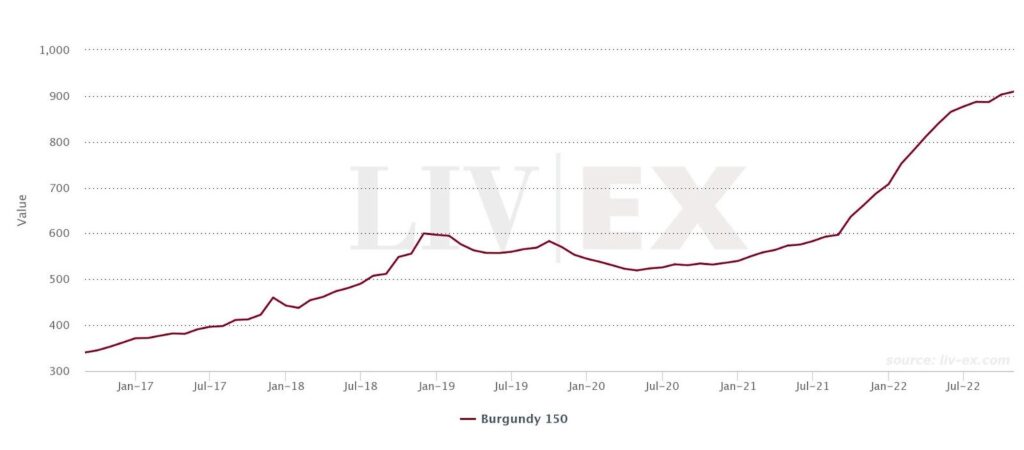Best Burgundy Wines to Pair With Your Investment Portfolio
Looking for an alternative investment with steady growth? Sip back and relax—here’s what you need to know about the best Burgundy wines.

“All that is rare is expensive. A cheap Burgundy is rare. So a cheap Burgundy is expensive.”
Burgundy wines experienced an increase of 115% in the last five years.
This cheeky saying contains a lot of truth because the finest Burgundies are astronomically expensive. The price tag for a bottle of a 2007 Domaine Leroy Musigny Grand Cru will run you about $40,000.
That’s right, this fine red wine costs around the same as a luxury car.
Unlike cars (which tend to depreciate after you drive them off the lot), the value of red Burgundy wines has experienced steady growth. This rise is tied to factors that drive up the cost, such as scarcity caused by limited production and high demand due to an elite reputation.
The Burgundy wine is one of the fastest-growing asset classes, surpassing 50% market share for the first time in history in August 2022.
So, will Burgundy pair nicely with your portfolio? Let’s find out.
What makes Burgundy wines special?
The Burgundy wine region in France is known for producing red wines from Pinot Noir and Chardonnay grapes. Burgundy red wines can often be described as having silky tannins and rich, velvety textures. White Burgundy wines are an easy-to-drink, refreshing, and citrusy beverage.
Bordeaux, another popular wine, comes from southwestern France. Burgundy is a fraction of the size of Bordeaux, with the former taking up 25,000 hectares compared to the latter’s 120,000.
Burgundy wines have unique flavors due in part to the area’s rich limestone soils and minerals. Burgundy is coveted for its vibrant acidity, which gives the wines time for tannins to fully blend over decades in a cellar. Some of the best Chardonnays are also produced in the Burgundy region.
The low production volume and high demand mean Burgundy wine bottles are regularly sought-after by wine collectors, investors, and enthusiasts.
Let’s find out what makes Burgundy a potential investment opportunity and which vintages (the year they harvested the grapes) are best for you to consider.
Are Burgundy wines a good investment?
Similar to other alternative investments, adding wine to your portfolio can be a way to diversify. Stocks and bonds have little to no correlation to wines, which means if the market goes through a downcycle, your nifty wine investment may continue to grow.
From January to October of 2022, Burgundy achieved returns of nearly 29%, according to Live-ex. The consistent performance and rising demand in new markets have contributed to Burgundy becoming a sound investment opportunity.
How Burgundy wines performed as investments
- Burgundy wines have proved to be steady, experiencing an increase of 37% over the last year.
- This exceeded the general wine trend of 13% from Liv-ex 100, which represents the prices of 100 of the most sought-after wines on the secondary market.
Burgundy performance over the last 5 years
The value of the top Burgundy wines has grown 115% compared to the 37% growth of the Live-ex 100 Fine Wine index. In contrast, the S&P 500 had an average five-year return of 42%.

Source: Liv-ex
The Liv-ex 1000 Fine Wine index, which is the broadest measure of the market tracking the top 1,000 wines globally, was slightly higher at 49%.
Burgundy wines have much lower production volumes and high demand, which therefore increases prices.
Downsides to Burgundy wines
The value of wine hinges on factors such as weather patterns, consumer trends, and harvest yields. This is why the vintage—the year the grapes were harvested—matters.
Some years may have a more coveted production than others. Because of this volatility in yields, you may end up paying sky-high prices for a certain release, never to see it again. And if you do, it’ll be way more expensive.
An ever-changing climate causes big storms and droughts, Burgundy wine yields may see a reduction. As one of the smallest wine regions globally, climate disruptions further fuel the scarcity of Burgundy wines and drive prices higher.
Although Burgundy has experienced its share of growth, there are also reports of a drop in sales and exports. Supermarket sales of Burgundy decreased by 25%, with exports to major markets, including sales in the U.S. sales falling by 10%.
Best Burgundy Wines to Invest in
Burgundy is known for its variability, so when choosing wines, it’s best to do so based on:
- The producer
- Relation to where the grapes are grown (known as appellation)
- Vintage (harvest year)
Domaine Leroy
A top wine producer from the Côte de Nuits or northern region of Burgundy, Domaine Leroy is a force to be reckoned with. The winemaker has a longstanding history of producing the most collectible wines in the world. Past productions for Domaine Leroy were tiny. Their 2010 Chambertin only produced two barrels. A few coveted wines include Domaine Leroy, Vosne-Romanee Premier Cru, Aux Brulees, 2013, and Domaine de la Romanée-Conti La Tache Grand Cru Monopole 2019.
Domaine Dujac
The critically lauded Domaine Dujac produces high-quality wines from Pinot Noir and Chardonnay, based in the Morey-Saint-Denis region. The wines are well-known for their freshness and fruitiness. A few highly regarded wines include Domaine Dujac Chambertin Grand Cru 2015, Côtes de Nuits, which costs $4,790 per bottle, and 2015 Domaine de la Romanee-Conti Romanee-Conti Grand Cru, Cote de Nuits, France, at roughly $35,000 per bottle.
Domaine de la Romanee-Conti
In 2012, this legendary Burgundy producer, Domaine de la Romanee-Conti, was awarded the “most important wine producer in the world” by the largest wine auction house, Acker Merrall & Condit. Domaine de la Romanee-Conti produces seven wines that vary in price.
Montrachet, La Tache, and Romanee-Conti are their most in-demand labels. Domaine de la Romanée Conti Romanée Saint Vivant Grand Cru 2015 is going for $4,486 per bottle, while Domaine de la Romanée-Conti Grand Cru 2015 is fetching around $35,000 per bottle.
Domaine Armand Rousseau
Hailing from one of the oldest wine estates in France, Domaine Armand Rousseau makes phenomenal and exotic Pinot Noir wines. The legend behind this winery is Armand Rousseau. In the early 1900s, his Domaine was among the first to bottle and sell his wines in bulk to local wholesalers. Their coveted 1959 Domaine Armand Rousseau Pere et Fils Chambertin Grand Cru goes for about $6,500 a bottle.
How to Invest in Burgundy Wines
Turning a profit on Burgundy means you need to know how to pick them. Even with the best and most trusted wine magazines and experts you can find on Google, it can be a tedious process.
That’s why investment platforms like Vint and Vinovest were created. They want to help you invest in expertly curated wines through easy-to-use technology. Plus, they provide bottle storage to keep your wines safe from harsh environmental conditions.
Here’s what you need to know about each platform, along with a few pros and cons.
Vint
Vint is a wine investing platform that allows you to buy shares of fine wines. It’s a solid way for beginners to invest in luxury Burgundys and other fine wines with a minimum investment of just $50.
Pros
- No annual management fee.
- Diversify your wine portfolio with fractional shares in wine collections.
- Invest in collections of wine and other rare spirits.
- Vint is regulated by the Securities and Exchange Commission (SEC).
Cons
- You can’t cash out on investments early—platform decides when to sell.
- Their choices for investments may be limited at any given time.
- Less flexibility and customization options compared to other platforms.
Vinovest
Similar to Vint, Vinovest is another platform that helps you develop a wine portfolio that meets your investing goals. The company has four investment tiers that let you gain exposure to top-tier wines starting at $1,000. Use Vinovest to invest in wines from the Burgundy region and other global wine markets.
Pros
- User-friendly interface makes it easy to start investing in wine.
- Build a custom wine portfolio in just a few weeks.
- Expert advisors can guide you through your investment.
- Access industry knowledge to identify the best wines to invest in.
Cons
- The $1,000 minimum may be too high for some investors.
- Portfolio customization depends on your tier level.
- They charge a 3% early liquidation fee if you withdraw funds in less than 3 years.
Rally
Unlike Vint or Vinovest, the fractional collectibles platform Rally doesn’t focus solely on wines. They’re a no-fee trading platform that lets you invest in all types of alternative assets by buying shares in them. From exotic sports cars to first edition classic books, Rally gives you more options if you want to go beyond wine.
Pros
- No commissions on secondary market trades or account management fees.
- Reasonably-priced shares make it simple and accessible for collectible investments.
- Great for investing in wines, whiskeys, and other rare collectibles.
- Investment opportunities are sourced by experts and pros in the industry.
Cons
- Rally typically holds on to assets for the long term—they are 10% stakeholders in all listed assets.
- No automated investment opportunities, so you can’t set it and forget it—investors must vote to accept buyouts.
- Can be less liquid than other investments.
Diversify Your Wines
Like you do with your stocks and bonds, diversifying the kinds of wine you have without placing too much weight on one vintage or producer is a good rule. You may want to achieve a certain balance with Burgundy wines—for example, a nice mix of bottles from well-established producers and newcomers can maximize returns.
While you likely won’t buy that $40,000 bottle of Leroy Musigny to sip with some seared tuna, you may want to buy it as an investment and hold on to it. If it’s out of your price range, there are plenty of other budget-friendly wines to choose from. Vinovest, Vint or Rally can help you get started with your investment so you can be ever so flute-ful.
